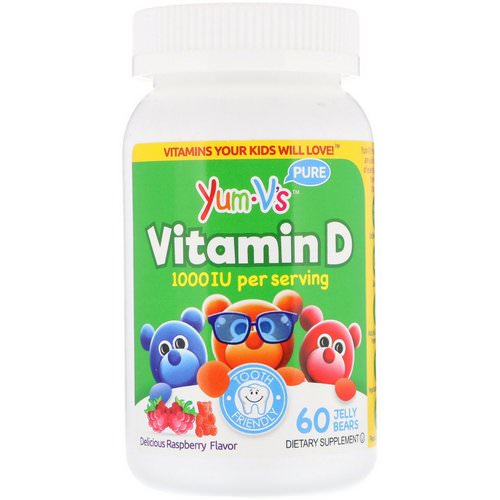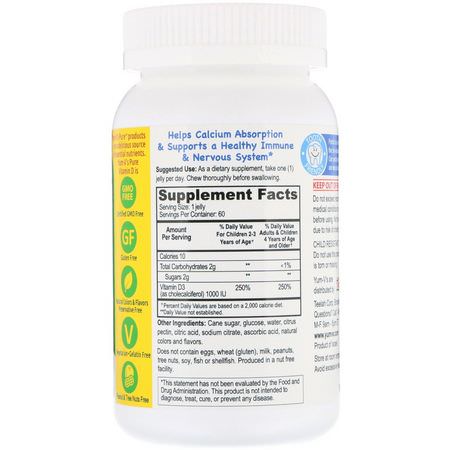Foodpharmacy Blog: Kids, Baby, Children's Health, Children's Vitamin D
YumV’s, Vitamin D, Delicious Raspberry Flavor, 1,000 IU, 60 Jelly Bears

$6.30
Product name: YumV’s, Vitamin D, Delicious Raspberry Flavor, 1,000 IU, 60 Jelly Bears
Quantity: 60 Count, 0.2 kg, 6.4 x 6.4 x 13 cm
Categories: Yum-Vs, Baby, Kids, Children’s Health, Children’s Vitamin D, Kosher, Non Gmo, Gluten Free, Vegetarian
Vitamins Your Kids Will Love! Pure, Tooth Friendly, Dietary Supplement, Kosher, Helps Calcium Absorption and Supports A Healthy Immune and Nervous System, Yum-V’s Pure products are a delicious source of essential nutrients. Yum-V’s Pure Vitamin D is: Certified GMO Free, Gluten Free, Natural Colors and Flavors – Preservative Free, Vegetarian – Gelatin Free, Peanut and Tree Nuts Free, Tooth Friendly – Pectin is a nutritional fiber and works to enhance the bio-availability of the vitamins and minerals. Our pectin jellies are softer than gummies and are less sticky. Sticky is icky!

Except during the summer months, the body makes little if any vitamin d from the sun at latitudes above 37 degrees north (In the united states, the shaded region in the map) or below 37 degrees south of the equator. Up4 kids sugar-free melts are for kids at least three years old to help build a healthy digestive and immune system. 1 These recommendations are summarized in table 5, although radiologic evidence of healing occurs within 2 to 4 weeks of treatment, large dose treatment (Of either vitamin d 3 or d 2) should be continued for 2 to 3 months. Vitamin d is an essential nutrient that plays an important role in calcium homeostasis and bone health. Rickets also occurs in children in resource-rich countries if sufficient vitamin d intake is not ensured through the use of supplements and fortified foods, particularly if exposure to sunlight is limited, and in children with chronic illnesses. The iom recommendations for vitamin d fail in a major way on logic, on science, and on effective public health guidance. More research is needed to evaluate the efficacy of vitamin d supplementations for pediatric patients with asthma and sickle cell disease. Low maternal vitamin d predisposes the fetus/newborn to low vitamin d stores as well leading to rickets, wheezing, and upper respiratory tract infections and mental health issues as noted before.
YumV’s, Vitamin D, Delicious Raspberry Flavor, 1,000 IU, 60 Jelly Bears: Children’s Vitamin D, Children’s Health, Kids, Baby
A big seller these days is vitamin d; a recent report concluded that vitamin d deficiencies may cause hypocalcemic seizures, growth disturbances and rickets and perhaps influence cardiovascular disease, diabetes and cancer. Excessive consumption of vitamin d can lead to over calcification of bones and the hardening of blood vessels, kidney, lung, and heart tissues. Major improvements are required for the effective promotion of vitamin d information to parents. Otherwise, once calcidiol concentrations are deemed adequate, maintenance doses of vitamin d 2 (400 Units daily) should be resumed. Additionally, literature from basic science and clinical studies on vitamin d in relation to current disease states will be presented. Zahler junior d3 provides children with all the benefits of vitamin d in the most healthy and natural way. In addition, people who are obese tend to have low vitamin d levels. In contrast to it’s name, vitamin d is not a vitamin, but rather a steroid hormone. Serum calcium concentrations plotted against 25ohd concentrations (Left) and vitamin d intake (Right) in infants and children with vitamin d intoxication. Supplement use with fortified foods; may not see the need to buy fortified products; habitual buying of the same products each time and other factors are considered of more importance than vitamin d content.
As a percentage; and safety of consuming fortified foods and drinks for fear of overdosing on vitamin d. Dosing recommendations for children younger than 5 years old are vitamin d 2 12,000 units biweekly, and 50,000 units weekly or biweekly of vitamin d 2 for those 5 years and older. 63 If high dose vitamin d 2 is inadequate, more polar vitamin d analogs, calcitriol, or phototherapy may be reasonable alternatives. Evidence in infants, children, and adolescents are sparse concerning what dose corrects vitamin d deficiency rickets. 77 Approximately 53% and 83% of the subjects were initially found to have vitamin d insufficiency and deficiency, respectively. It is important that breastfed infants receive an adequate supply of vitamin d through a supplement of 400 iu per day. Who child growth standards: Length/height-for-age, weight-for-age, weight-forlength,weight-for-height and body mass index-for-age. Additionally, while sunscreen is essential for children, it can decrease vitamin d creation. Taking 1,000 or 2,000 international units (Iu) a day of vitamin d is relatively safe. Vitamin d deficiency in children and it’s management: Review of current knowledge and recommendations. The vitamin d theory does not diminish the genetic or other environmental contributions; rather it may allow the genetic tendency of autism to express itself in a state of vitamin d deficiency. Do kids have different nutrient needs than adults?
The nordic naturals vegetarian probiotic gummy has a natural berry punch flavor for your child to enjoy. We also consider the number of additional active ingredients because lesser-known nutrients, such as choline, inositol, and lycopene have well documented health benefits, but are typically not included in the more basic multivitamin formulations. Growing children, especially those who do not eat a varied diet, sometimes do not get enough vitamins a and c. Many said that a vitamin d supplement would be preferential during pregnancy. A study in the journal of pediatrics this year found that adult-sized teens need at least 5,000 iu of vitamin d3 a day for 8 weeks to correct deficiency. A rct compared the use of budesonide alone to budesonide plus daily supplementation with vitamin d 500 iu in children newly diagnosed with asthma. The upper limit that healthcare professionals recommend for vitamin d is 4,000 iu per day for an adult. These rare cases represent the most extreme descriptions of in utero vdd, but there is increasing evidence that subclinical maternal vitamin d insufficiency in pregnancy might also influence offspring bone mineral accrual.
Nutrients that help build bones and promote brain development are especially significant in childhood. Your kids will be able to digest certain foods easier with probiotics and the right amount of good bacteria. Will continue to give these to all three kids through the sick months and will reevaluate. This sample was a well-educated population, which makes the findings of more concern that awareness and understanding of the importance of vitamin d intake in children in this sample is poor, and therefore highly likely that awareness would be lower in those less educated, which could result in further health inequalities. There were very mixed results in whether parents felt they would use fortified foods for vitamin d intake. Two hundred and forty-five healthy infants, aged between 6 and 24 months, followed at two near municipal primary health care units, were invited to participate. 25(Oh)d, though metabolically inactive, is the major circulating from of vitamin d. The most common symptoms of excessive vitamin d include headache and nausea. Although people can take vitamin d supplements, it is best to obtain any vitamins or minerals through natural sources wherever possible. The smartypants probiotic for kids is a strawberry and creme flavored chewable vitamin. Among these cases, there is significant variability in the amount of vitamin d administered and the resulting serum 25ohd concentrations. Davis children’s hospital have estimated that one-third of u. Vitamin d supplementation for childhood asthma: A systematic review and meta-analysis.
Yum-Vs Children’s Vitamin D
Experts call for more studies, and this statement cannot be more compelling than in pediatrics where data on the safety and long-term use of high vitamin d doses are limited. Aside from the detrimental bone effects of vitamin d deficiency, rapid decreases in calcium may precipitate a seizure, further complicating the clinical picture (E. While some probiotics may seem helpful, your pediatrician will be able to determine if probiotics are necessary for your child specifically. Made with the highest quality and natural ingredients, one tablet a day is what you child needs to ensure optimal vitamin d levels. The prevalence of vitamin d insufficiency or deficiency in the pediatric population with ckd varies in recent literature from 39% to 77%. Vitamin d deficiency among healthy infants and toddlers: A prospective study from irbid, jordan. For a child who is deficient, a standard dose of 400 iu will not correct this problem. If your child follows a restrictive diet, cannot adequately absorb nutrients, or is a picky eater, they may benefit from taking vitamins.
If children have too little of a given nutrient, they can suffer a deficiency disease. Animal studies and a limited number of observations from human cases offer insight into alterations in vitamin d metabolism during states of intoxication (37, 38, 41, 42). Fat-soluble vitamin supplements for enterally fed preterm infants. A small number of pediatric studies tested vitamin d doses at or above the currently recommended upper tolerable intake. 42, 43 Based on this evidence, most guidelines recommend at least 400 units of vitamin d daily. Can food vouchers improve nutrition and reduce health inequalities in low-income mothers and young children: A multi-method evaluation of the experiences of beneficiaries and practitioners of the healthy start programme in england. Indeed, increased free 1,25(Oh) 2d concentrations with normal total 1,25(Oh) 2d levels were reported in adults with vitamin d intoxication. Many parents had not been informed why they need to take a vitamin d supplement and the importance of vitamin d for their baby/child was not made clear. Regular dosage of probiotics helps prevent and reduce the risks of many health concerns that parents face. Share on pinterest during sun exposure, a person’s body produces vitamin d. Plant sterols activated by uvb irradiation produce vitamin d-2, in animals and humans, 7-dehydrocholesterol, the vitamin d precursor found primarily in the epidermal layer of the skin, is activated by sunlight to produce vitamin d-3 and is bound to vitamin d binding protein (Vbp).
Vitamin d supplementation: We must not fail our children! The latest american association of poison control centers annual report documents over 32,000 concerned calls relating to pediatric vitamin exposure in children 12 and younger. 8, 31, 51 However, vitamin d 3 is noted as an acceptable alternative. 46 Additionally, these patients exhibit physiologic challenges that increase risks for deficiency, including decreased endogenous production, decreased intestinal absorption, decreased enzyme activity to form functional vitamin d in the kidneys, and in those with proteinuria, increased urinary loss of calcidiol, and vitamin d-binding protein. For example, do not give them cod liver oil and vitamin drops, as cod liver oil also contains vitamins a and d. It is generally the best indicator of overall vitamin d status and is used to correlate vitamin d stores with clinical disease. Gummy vitamins, a popular choice for children, proved more likely to fail the test than other vitamin types. Vitamin d deficiency in healthy children in a sunny country: Associated factors.
Get the latest news on health and wellness delivered to your inbox! Implications of a new definition of vitamin d deficiency in a multiracial us adolescent population: The national health and nutrition examination survey iii.